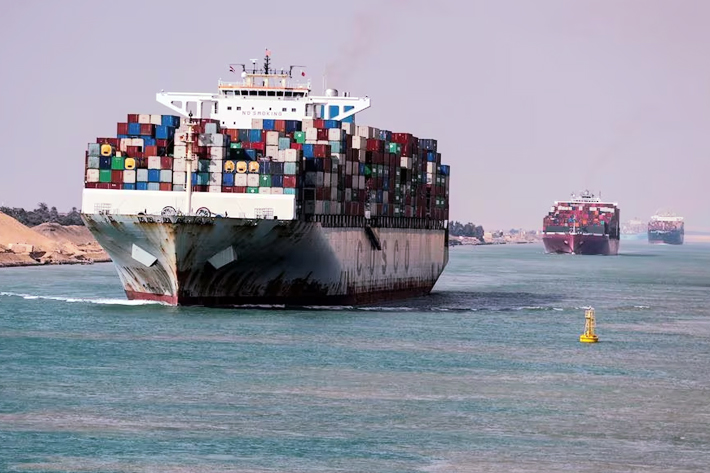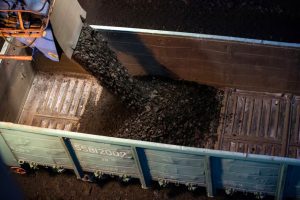US and British warships shot down a flurry of drones and missiles fired by Houthi rebels at commercial ships sailing through the Red Sea late on Tuesday, according to the Pentagon.
The Iran-backed Yemeni militants launched their largest ever barrage of 18 drones and three anti-ship missiles at about 9.15pm, but they were all shot down by three US vessels and one British navy destroyer, plus fighter jets from the USS Dwight Eisenhower aircraft carrier.
There were several commercial vessels in the area near the attack but no damage was reported, US officials said.
Also on AF: China Says it Overtook Japan to be World’s Top Car Exporter
The attack – the 26th by Houthi forces since mid-November – came despite a warning that the UN Security Council plans a vote later tonight (Jan 10) to demand a halt these assaults.
The rebels’ actions aim to convince Western leaders they must force Israel to end its war on Hamas in the Gaza Strip because of the huge suffering it has inflicted on Palestinian citizens.
Container vessels most disrupted, tankers less affected
To date, oil and fuel tanker traffic in the Red Sea has been largely unaffected by the attacks. Container ships have made up most of the vessels that have been forced to reroute and sail around the bottom of Africa, vessel tracking data shows.
The attacks have driven up shipping costs sharply along with insurance premiums, but have had less impact than feared on oil flows, with shippers continuing to use the key East-West passage. The Houthis, who have said they are targeting Israel-bound vessels, have largely attacked non-petroleum goods shipments.
The added costs have not made a big difference to most shippers so far because the Red Sea remains much more affordable than sending cargo around Africa.
But the situation bears watching as some oil companies like BP and Equinor are diverting cargoes to the longer route. Also, increased shipping costs are likely to boost exports of US crude to some European buyers, experts said.
“We haven’t really seen the interruption to tanker traffic that everyone was expecting,” said Michelle Wiese Bockmann, a shipping analyst at Lloyd’s List.
A daily average of 76 tankers carrying oil and fuel were in the south Red Sea and Gulf of Aden in December, the area close to Yemen that has seen attacks. That was only two fewer than November’s average and just three below the average for the first 11 months of 2023, according to data from ship tracking service MariTrace.
Rival tracking service Kpler tracked 236 ships on average daily across all of Red Sea and Gulf of Aden in December, slightly above the 230 daily average in November.
The additional cost of sailing around the Cape of Good Hope off Africa rather than via the Red Sea would make voyages to deliver oil less profitable, she said.
Since the beginning of December, chartering rates have roughly doubled, according to data from ship analytics firm Marhelm. It cost as much as $85,000 a day to ship oil on Suezmax tankers, which can carry as much as 1 million barrels. Aframax vessels, which can move 750,000 barrels, cost $75,000 a day.
Tanker traffic in the south Red Sea region briefly dipped between December 18 and December 22 when the Houthi group intensified attacks on vessels, averaging 66 tankers, but movements resumed after, according to MariTrace.
Houthis Ignore Russian Crude
Container ship traffic in the area has fallen more sharply, down 28% in December from November, with steep declines in the second half of the month as attacks mounted, according to MariTrace.
Several oil majors, refiners and trading houses have continued to use the Red Sea route, according to an analysis of LSEG data.
“Shippers and their customers really want to avoid a schedule disruption. So they are still taking the risk,” said Calvin Froedge, founder of Marhelm.
He noted that many oil tankers transiting the Red Sea were carrying Russian crude to India, which the Houthis have no interest in attacking.
Using the Red Sea can some 3,700 nautical miles off a trip from Singapore to Gibraltar.
Some companies such as BP and Equinor have paused all transits through the Red Sea and rerouted their vessels in the region.
Since the second half of December, at least 32 tankers have diverted or transited via the Cape of Good Hope, instead of using the Suez Canal, according to ship tracking service Vortexa.
The tankers that are diverting are mostly those chartered by companies who announced a pause on Red Sea movement, or those operated by US and Israel-linked entities, Vortexa added.
Retailers stocking up for Chinese New Year
Meanwhile, retailers worldwide are stocking up on goods before the Chinese New Year break and seeking air or rail alternatives to transportation via the Red Sea in a scramble to avoid empty shelves this spring, executives and experts said.
One European retailer said it was delaying marketing campaigns for some specific goods until stocks were secured.
Companies transporting goods from China to Europe and the US are considering alternatives like rail and air, but high prices mean they have to be strategic about which products to prioritise.
Even though Asia-to-Europe trade is most exposed to the Suez disruptions, as much as 30% of shipments to the US East Coast move via the canal.
Retailers are also in a race against time: on February 10 factories in China close for anywhere from two weeks to a month for the Lunar New Year holiday, so companies typically try to export as much as possible beforehand.
But with vessels rerouted, fewer ships will be back in China in time to load cargo before the holiday. That means likely delays to products meant to land on Western shelves in April or May. Logistics experts are already reporting a container shortage at Ningbo port in China.
For some companies, the latest disruptions highlight the need to shift supply chains so factories are closer to the end consumer, a process called “near-shoring”.
- Reuters with additional editing by Sean O’Meara and Jim Pollard
NOTE: This report was updated on January 10 with details about the attack on January 9 and impacts on retailers.
Read more:
Militants Get ‘Final Warning’ After Red Sea Missile Launch – AP
Ocean Freight Fees Shoot up After New Red Sea Ship Attacks
Maersk Halts Red Sea Routes Again After Latest Attack – CNN
Cargo Rates Soar as Firms Assess Bid to Protect Red Sea Ships
Chinese Car Exports to EU Seen Hit by Red Sea Ship Attacks























